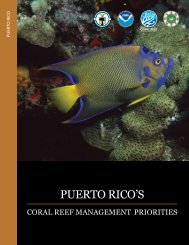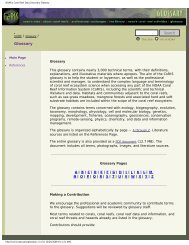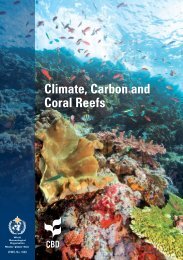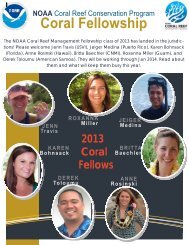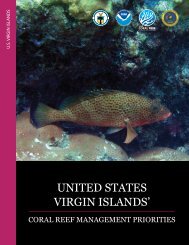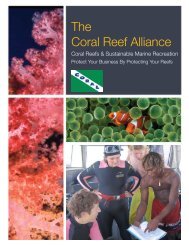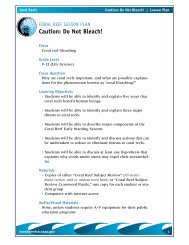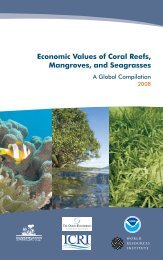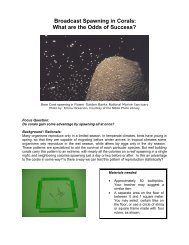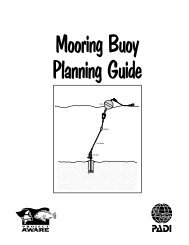Deep-Sea Coral Collection Protocols - NOAA's Coral Reef ...
Deep-Sea Coral Collection Protocols - NOAA's Coral Reef ...
Deep-Sea Coral Collection Protocols - NOAA's Coral Reef ...
- No tags were found...
Create successful ePaper yourself
Turn your PDF publications into a flip-book with our unique Google optimized e-Paper software.
Appendix 3. <strong>Deep</strong>-sea corals onlineNOAA <strong>Coral</strong> <strong>Reef</strong> Information Systemhttp://www.coris.noaa.gov/about/deep/deep.htmlThis portal favors Atlantic scleractinia, with links to myriad other online documents describing deep ahermatypicreefs. It includes lovely images, and a dense bibliography on Lophelia sp. and Oculina sp.Octocoral Research Center at the California Academy of Scienceshttp://www.calacademy.org/research/izg/orc_home.htmlThis website created and maintained by Dr. Gary C. Williams at the California Academy of Sciences. Thebibliography from Bayer is exhaustive, at ~50 pages in its original form. The list of genera is extensive, and includesmany photographs.Report of the International Council for the Exploration of the <strong>Sea</strong> (ICES) Study Group on <strong>Deep</strong>-sea<strong>Coral</strong>s. 2003.http://www.ices.dk/reports/ACE/2003/SGCOR03.pdfUN Status Report on Cold-water <strong>Coral</strong> <strong>Reef</strong>s. 2004.NOAA Office of Ocean Exploration Websitehttp://www.unep-wcmc.org/press/cold-water-coral-reefs/Gulf of Alaskahttp://www.oceanexplorer.noaa.gov/explorations/02alaska/welcome.htmlhttp://www.oceanexplorer.noaa.gov/explorations/04alaska/welcome.htmlThe 2002 and 2004 Gulf of Alaska <strong>Sea</strong>mount Expeditions (GOASEX) visited a dozen seamounts in the NortheastPacific Ocean with the Alvin submersible, collecting several excellent specimens. An 2002 article in the missionbackground and the July 7 th log describes dispersal studies. The July 14th log details some problems withmorphological classification in the Family Isididae. The 2004 August 16 th log discusses octocoral sampleprocessing, while the August 19 th log discusses and exhibits living polyp photography. August 17 th describes the“paradox of seamounts.”North Atlantichttp://www.oceanexplorer.noaa.gov/explorations/03mountains/welcome.htmlhttp://www.oceanexplorer.noaa.gov/explorations/04mountains/welcome.htmlThe 2003 and 2004 Mountains in the <strong>Sea</strong> Expeditions also made some fascinating finds, and they detailsophisticated methods in the 2003 July 15 Daily Log by Scott France. Visiting a seamount is a special event, butreturning to a previously visited seamount is truly rare. Three seamounts, Manning, Kelvin, and Bear, hadspectacular gardens of octocorals.Gulf of Mexicohttp://www.oceanexplorer.noaa.gov/explorations/03mex/welcome.htmlAn interdisciplinary scientific team spends 12 days exploring deep-sea coral habitats in the Northern Gulfof Mexico. <strong>Deep</strong> corals are widely distributed in a region heavily utilized by the oil and gas industry.Hawaiian Islandshttp://oceanexplorer.noaa.gov/explorations/03nwhi/welcome.htmlThe 2003 Expedition to the Northwestern Hawaiian Islands studied the reproductive biology andpopulation genetics of precious corals in the Hawaiian archipelago. This site contains first ever footage ofan endangered monk seal foraging in precious coral beds.49





